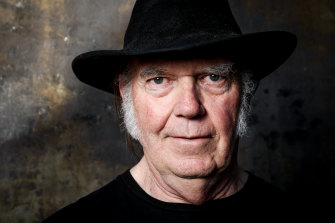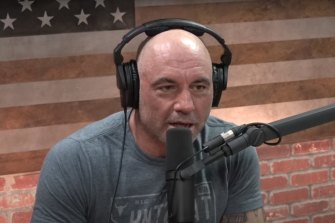Like a hurricane, Neil Young’s decision to remove his music from Spotify over the “dangerous life-threatening COVID falsehoods” aired on The Joe Rogan Experience has ripped up the world we knew, tossed it in the air, and left us wondering where the pieces will fall.
Alternatively, this protest by an old man whose fading cultural relevance was perhaps encapsulated in the hashtag #whoisneilyoung is but a storm in a teacup in a world full of coffee drinkers. In other words, meh.
Can both be true? Well, yes.
Neil Young removed his music from Spotify in protest at “misinformation” about COVID aired on Joe Rogan’s podcast.Credit:Invision/AP
The 76-year-old Canadian rocker is a genuine music industry legend, whose most recent album, Barn, was released last December and whose extensive back catalogue racked up more than 6.1 million listens a month on Spotify prior to last week’s order (delivered by his label, Warners, on his behalf) to take it down. Since then, fellow artists (and friends) Joni Mitchell and Nils Lofgren have followed suit, while the unsubstantiated rumour mill (or mere wishful thinking) suggests Bruce Springsteen, Foo Fighters, even Paul McCartney could soon follow.
Meanwhile, some Spotify subscribers have taken to social media to proclaim #istandwithneilyoung and to post proof of their cancelled accounts. The numbers are small, but the sentiment appeared to spook investors briefly – pushing the market capitalisation of the company down 12 per cent as the crisis unfolded last week.
Spotify boss Daniel Ek certainly takes the threat to his $US33 billion company seriously. On January 30, he wrote on the company’s For The Record blog that Spotify was “working to add a content advisory to any podcast episode that includes a discussion about COVID-19”.
Joe Rogan is one of the superstars of podcasting.
Listeners would be directed to the company’s COVID-19 Hub, “a resource that provides easy access to data-driven facts, up-to-date information as shared by scientists, physicians, academics and public health authorities around the world, as well as links to trusted sources”. He committed Spotify to a “new effort to combat misinformation”, claiming the content advisory was “the first of its kind by a major podcast platform”.
By Tuesday morning Rogan had taken to Instagram to declare himself “a Neil Young fan” and to promise to “do my best in the future to balance things out”, and the company’s share price had largely recovered (though it is still worth only slightly more than half what it was a year ago).
But that’s not the only reason Rogan isn’t going to be cancelled any time soon.
For a start, Spotify reportedly paid Rogan around $US100 million in May 2020 to move his podcast exclusively to its platform from September that year. For that, they got access to his back catalogue (more than 1700 episodes), his subscribers (more than 9 million when the deal was struck), and the opportunity to sell advertising to his podcast, episodes of which regularly run for more than two hours.
If Spotify was being asked to take sides there was only one crazy horse it was ever going to back, and that was Rogan.
Young (who contracted polio as a child, and has every right to feel passionately about vaccines) has an audience, but it is an ageing one. According to a survey conducted by Media Monitors in January 2020, the average age of Rogan’s listeners (71 per cent male) is just 24.
The dollars all fall in Rogan’s favour. Even if Young’s music was earning the highest rate Spotify pays – $0.0084 per stream – those 6.1 million listens would bring in just $51,240 per month, 70 per cent of which goes to the copyright holders. An ad on Rogan’s show is likely, according to one recent report, to sell for a minimum of $1 million.
More broadly, Rogan also plays a crucial role in reshaping the perception of what Spotify is – no longer a music streaming platform, but a publisher of audio and video content of all sorts.
Given all this, the reputational damage, subscriber loss and share-price hit would have to be enormous for Spotify to even consider siding with Young and co in this dispute – and minus the defection of some seriously big names (Adele, Taylor Swift, Justin Bieber) it’s hard to see that happening. The fact Young has long been critical of the audio quality of the service – and that Apple Music has moved swiftly to position itself as the new streaming home of both him and Mitchell – only adds to the unlikeliness of such a move.
As a guest on Rogan’s show, Dr Robert Malone helped popularise an unfounded theory suggesting millions of people have been “hypnotised” into believing mainstream ideas about COVID-19. Credit:AP
Young and Mitchell are certainly not alone in being alarmed that Rogan – who is now one of the most powerful voices in media globally – is propagating controversial and potentially dangerous views about COVID-19. On January 10, “a coalition of scientists, medical professionals, professors, and science communicators” wrote to Spotify to raise their concerns, and to call on the company to “immediately establish a clear and public policy to moderate misinformation on its platform”.
Perhaps inevitably though, Young and Mitchell have been labelled hypocrites over their intervention, with these former flag bearers of the counterculture accused of trying to deplatform Rogan. It barely matters that they haven’t done this at all (they have merely removed their work from the platform they shared with him) because the issue has been framed (misleadingly) as an attempt to stifle free speech, rather than as the act of protest it really is.
When the dust has settled and everyone can assess the needling and the damage done, what are they likely to find? Undoubtedly, Young has succeeded in putting a spotlight on the presence of Rogan’s more problematic material, and not just the stuff that pertains to COVID-19. Probably that some people have cancelled Spotify and will leave it cancelled. But possibly that the episode has led to Rogan and his conspiracy theory guests people who otherwise might not have found them.
Young is wealthy enough to be able to take the hit that leaving the platform represents and powerful enough to use the moment to make a point. In the end, it might not change a thing, but there comes a time in a person’s life when you’ve just got to take a stand.
As the man says, it’s better to burn out than it is to rust.
Email the author at [email protected], or follow him on Facebook at karlquinnjournalist and on Twitter @karlkwin
Most Viewed in Culture
From our partners
Source: Read Full Article



